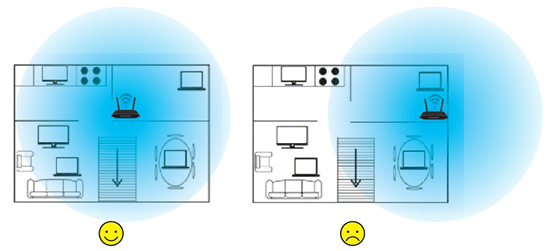6 Tips on Where to Place Your Wireless Router for the Best Signal/Coverage
When you find that WiFi coverage cannot meet your needs, the first thing that might come to your mind is to buy a new mesh router or WiFi extender. Sure, a mesh router or WiFi extender can indeed improve your WiFi coverage and bring some dead zones back to life. But do you really need them? Have you ever thought about how the position of your router could have a significant impact on your WiFi coverage?
WiFi signal strength and range depend on factors such as frequency band, radio power output, receiver sensitivity, antenna gain, and antenna type as well as the modulation technique. The environment also plays a pretty major role in the coverage and performance of a wireless product. Floors, walls, physical obstacles, and radio signal interference weaken WiFi signals, decreasing the WiFi range.
So in many cases, the easiest and least costly way to improve WiFi coverage is moving your router to a better position. Here we will give some tips for finding the best spot for optimal WiFi performance of your router.
Tip 1. Position your wireless device in a central location.
WiFi signal broadcasts in all directions, so don’t leave your router in the corner of your home, otherwise, your wireless coverage will be significantly decreased. If possible, put your wireless router close to the center of your house to cover more space.

Tip 2. Put your wireless device at a certain height.
Home WiFi products generally use omni-directional antennas, which radiate horizontally all around but are weaker vertically. Place your wireless device on a table or shelf and keep it slightly higher up to better utilize the transmission from the omni-directional antennas.
Tip 3. Stay away from high-powered appliances/other electronics.
High-powered electrical appliances and metal products may cause signal interference. Appliances to watch out for include microwaves, refrigerators, TVs, among others. Pay special attention near a microwave because it emits a very strong signal in the 2.4 GHz band.
Tip 4. Avoid obstacles.
One of the materials most likely to block WiFi signals is metal. Large metal objects like a steel table or a refrigerator can reflect and absorb WiFi signals, thereby creating a WiFi dead zone. Adjust the position of your wireless router so that the WiFi signal is not absorbed by metal and does not need to pass through many walls, cabinets, furniture, or other obstacles.
Tip 5. Keep your device safe.
Keep your wireless device away from water or fire and avoid heat and humidity to prevent device damage that’ll negatively impact your wireless performance.
Tip 6. Adjust the antennas.
Place antennas at an angle oblique to the ground.
If your wireless device has two antennas, the recommended angle is between 45 degrees and 60 degrees. If it has three antennas, you can position the middle antenna straight up.
You can also refer to the product image on the relevant poster and/or user manual for antenna placement.
Remember all of these tips to place your router for optimal coverage. If your router just isn’t cutting it, consider investing in a Range Extender, Powerline Adapter, or Mesh WiFi system.




